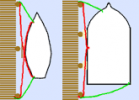- Joined
- Jan 5, 2021
- Messages
- 199
- Reaction score
- 24
- Points
- 18
- Location
- South Coast MA
- Model
- Express 330
Loving this blog so I can't stay off it. Sold my 21' and moved up to a 330 express. In your experience, what do you suggest for dock lines? Size and length. I am a fan of braid as opposed to triple strand. Thoughts?


